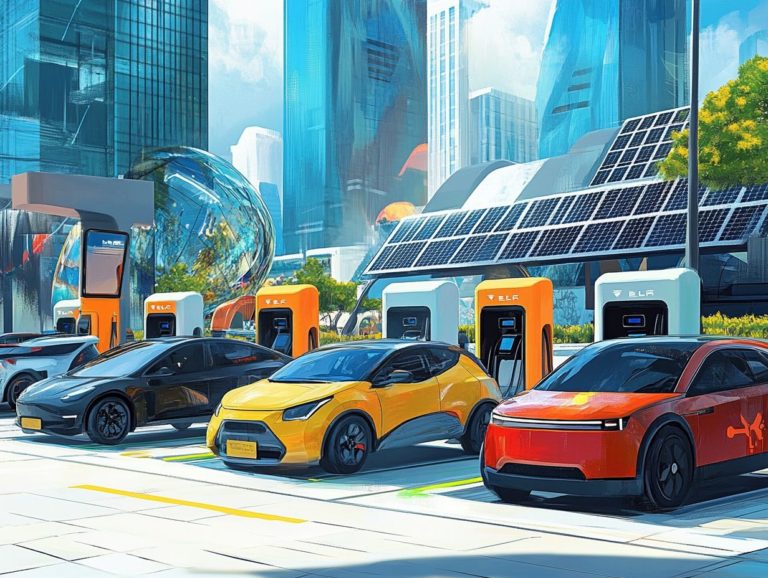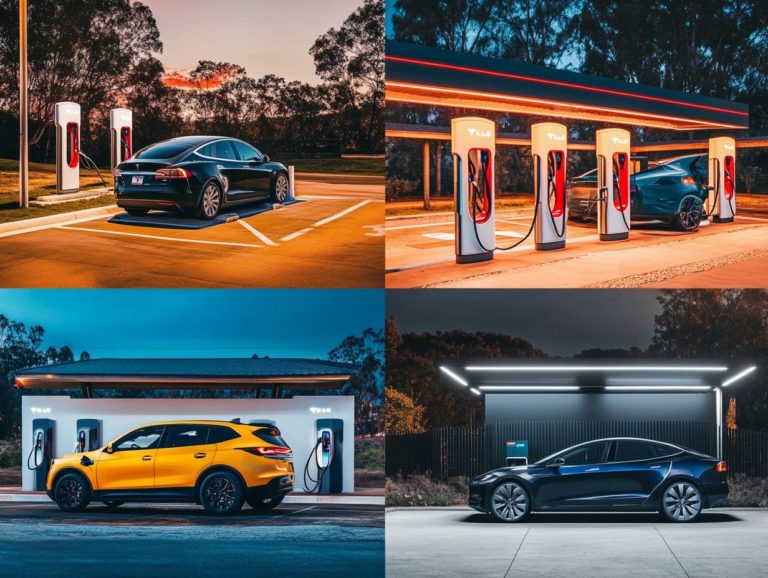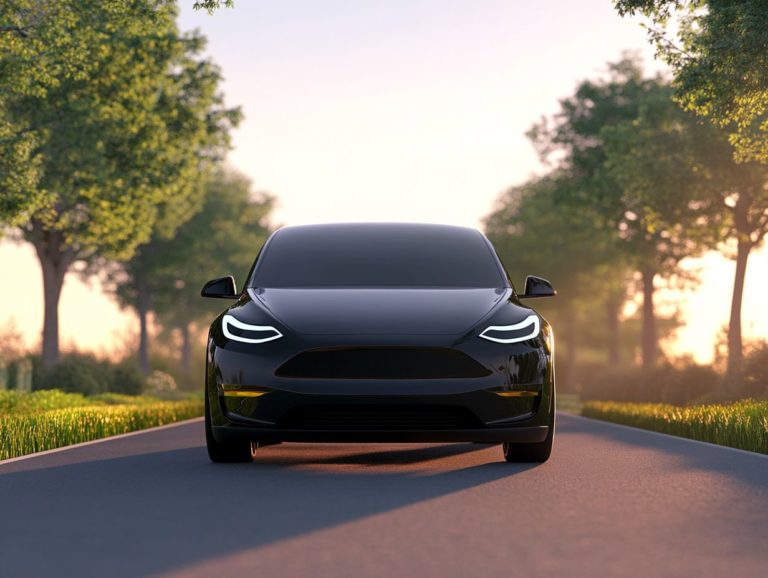5 Common Electric Vehicle Problems and Solutions
Electric vehicles (EVs) are revolutionizing how we think about transportation! However, there are still some hurdles to consider before you make the leap.
From limited driving ranges and long charging times to higher initial costs, these factors can understandably make some people hesitant about switching to electric.
This article explores five common challenges associated with EVs and highlights innovative solutions currently in development to address them.
With advancements in technology and improvements in infrastructure, along with practical tips for you, navigating these decisions becomes much simpler.
Whether you re an EV enthusiast or just curious about the electric vehicle landscape, this guide offers valuable insights and answers to your questions.
Contents
- Key Takeaways:
- 1. Limited Driving Range
- 2. Longer Charging Time
- 3. Lack of Charging Infrastructure
- 4. Higher Upfront Cost
- 5. Battery Degradation
- How Can These Problems Be Addressed?
- What Are the Advancements in EV Technology to Improve Driving Range?
- How Can Charging Time Be Reduced?
- What Are the Efforts Being Made to Improve Charging Infrastructure?
- Are There Any Incentives or Programs to Make EVs More Affordable?
- What Are the Steps to Maintain and Prolong the Life of an EV Battery?
- What Are the Future Predictions for EVs and Their Potential Solutions?
- How Can Consumers Make Informed Decisions When Purchasing an EV?
- Frequently Asked Questions
- What are the top 5 common problems with electric vehicles?
- How can range anxiety be addressed in electric vehicles?
- What causes battery degradation in electric vehicles?
- What can be done to improve the slow charging speed in electric vehicles?
- What is being done to expand the charging infrastructure for electric vehicles?
- Is there a solution to the high upfront cost of electric vehicles?
Key Takeaways:

- Electric vehicles have a limited driving range, but technology is continually improving this issue.
- Charging time for EVs can be longer than traditional vehicles, but efforts are being made to reduce this time.
- One major barrier to widespread EV adoption is the lack of charging infrastructure, but there are ongoing efforts to enhance it.
1. Limited Driving Range
Limited driving range is a significant concern for electric car owners, impacting satisfaction and the adoption rates of electric vehicles across different demographics. This issue is especially evident in regions with varied driving habits, such as Florida or Alaska. You might feel the fear of running out of battery while driving when considering models like Tesla or electric SUVs, which can still face some mechanical issues with their batteries.
Several factors contribute to this limited range, including your driving style, the terrain, and variations in battery sizes among different models. For example, if you’re driving in an urban area, you may notice shorter distances compared to someone in a rural setting. Fortunately, ongoing advancements in battery technology aim to boost performance and ease these worries.
Despite these innovations, some vehicles may still encounter reliability issues that could make you hesitant about purchasing. This highlights the need for comprehensive consumer education on the evolving landscape of electric cars, ensuring you make informed choices for your driving needs.
2. Longer Charging Time
Longer charging times can really make you think twice about switching to electric vehicles! After all, it s tough not to compare those durations to the quick refueling you re used to with traditional cars, raising valid concerns about performance and convenience.
This hesitation grows with the demands of daily life; many people prioritize quick refueling when making these decisions. Enter fast charging solutions these innovations are game-changers, significantly reducing the time you spend at charging stations compared to standard options.
Consumer reports consistently show that rapid recharging boosts overall satisfaction with electric vehicles. As technology continues to evolve, automakers are focusing on reducing charging times to enhance your experience.
With improvements in battery technology, charging is becoming more efficient, and you re gaining confidence in the practicality of going electric. This makes it a crucial factor for anyone considering the leap into the world of EVs.
In conclusion, while there are challenges to adopting electric vehicles, ongoing advancements and innovations are paving the way for a more convenient and enjoyable experience. Explore your options and consider making the switch today!
3. Lack of Charging Infrastructure
A lack of charging infrastructure is one of the biggest barriers to adopting electric vehicles. This creates a sense of range anxiety among potential buyers, which affects their satisfaction with vehicle ownership.
This issue is particularly severe in rural areas and regions where awareness of electric vehicles is limited. Consumers understandably hesitate, worrying about being stranded without enough charging options. As you consider making the switch to an electric vehicle, uncertainty about the availability of charging stations can dampen your enthusiasm.
In response to these challenges, various government initiatives aim to enhance this infrastructure. They offer funding and incentives to encourage companies to install more charging points. Private enterprises are also collaborating with local governments to expand charging networks. This joint effort not only builds confidence in potential buyers but also promotes broader acceptance of electric vehicles.
4. Higher Upfront Cost
The higher upfront cost of electric cars compared to traditional vehicles can deter many consumers, even when considering the long-term savings and environmental benefits these vehicles offer.
Although the initial investment may appear daunting, it’s essential to consider factors like fuel savings, maintenance costs, and potential tax rebates that can ease financial burdens over time. Hybrid vehicles often seem more economical due to their moderate price tags and decent fuel efficiency, but they may not deliver the same savings as purely electric models.
Numerous government incentives, such as tax credits and subsidies, along with manufacturer rebates, can significantly lower the effective price of electric vehicles. This makes them more accessible to a wider audience.
By analyzing these factors, you can make informed decisions that align with your financial goals and environmental values.
5. Battery Degradation

Battery degradation significantly impacts the lifespan and performance of electric vehicles. This raises important questions about maintenance checks and how lithium-ion batteries measure up against traditional systems.
How you drive your car can wear down the battery faster. Factors like rapid acceleration, frequent braking, and exposure to extreme temperatures can lead to a noticeable decline in energy capacity and efficiency.
The geographical area and climate where you operate your vehicle can worsen these issues, emphasizing the need for proactive care. Regular maintenance checks and professional repair services are vital to preserving battery health, maximizing your investment, and extending your electric vehicle’s overall efficiency.
How Can These Problems Be Addressed?
Exciting innovations are transforming the EV landscape, making it crucial to find innovative solutions that utilize advancements in EV technology, refine charging options, and enhance vehicle performance. This leads to greater environmental benefits and boosts owner satisfaction.
Innovations such as fast-charging stations are drastically cutting downtime, making EVs a more convenient option. Manufacturers are partnering with governments to enhance charging infrastructure and tackle range anxiety for potential users.
As more charging points become accessible, the goal is to create a seamless experience for you as a driver. Various incentives, including tax breaks and rebates, are emerging to promote EV adoption.
A growing trend in subscription services offers a flexible ownership approach, allowing you to enjoy the benefits of electric vehicles without a long-term commitment. This eases the financial transition to cleaner transportation.
Ready to make the switch to an electric vehicle? Now is the time to explore your options!
What Are the Advancements in EV Technology to Improve Driving Range?
Recent advancements in electric vehicle (EV) technology are elevating your driving experience by significantly enhancing range. Innovations in battery capacity and energy management systems which are systems that optimize how energy is used in your vehicle are evident in various Tesla models and electric SUVs.
Among these innovations, lithium-silicon batteries are a true game changer. They boast higher energy densities, allowing your electric vehicle to travel farther on a single charge. Meanwhile, a new type of battery technology called solid-state technology improves safety and charging speed, making electric mobility more accessible.
Models like the Ford Mustang Mach-E and Hyundai Ioniq 5 exemplify the competitive landscape. Each showcases impressive ranges fueled by cutting-edge energy recovery systems. As a consumer, you now find yourself in a burgeoning market with diverse options that allow for longer trips while promoting increasingly efficient energy use. These advancements are setting new standards for future vehicles.
How Can Charging Time Be Reduced?
Reducing charging time is essential for enhancing your electric vehicle driving experience. With advancements in fast charging technologies and a growing number of charging stations, this is becoming a game changer for drivers everywhere!
As more individuals transition to electric vehicles, these innovations streamline the refueling process, making long-distance journeys more practical. Imagine having access to ultra-fast chargers that can deliver 80% charge in under 30 minutes. This allows you to make spontaneous travel plans without the dread of long wait times.
The rapid expansion of charging infrastructure spanning from urban hubs to convenient highway stops means finding a charging station is becoming increasingly effortless. This evolution in charging convenience is set to transform driving habits, encouraging you to embrace electric vehicles as a natural part of daily life.
What Are the Efforts Being Made to Improve Charging Infrastructure?
Significant efforts are underway to enhance charging infrastructure, with both government initiatives and private sector investments focused on boosting the availability and reliability of charging stations for electric vehicles.
Recent collaborations between federal and state governments and major automotive companies reflect this commitment. They are working to establish a seamless network of fast-charging stations that span both urban and rural areas. Insights from consumer reports emphasize the importance of accessibility and the varying success rates of locations in delivering reliable service.
A key concern for consumers extends beyond the number of stations; it s about their operational efficiency and ease of use. This highlights the ongoing need for improvements and strategic partnerships within the electric vehicle infrastructure landscape.
Are There Any Incentives or Programs to Make EVs More Affordable?

Various incentives and programs are crafted to make electric vehicles more accessible to you. These initiatives promote both electric and hybrid options, highlighting their long-term environmental advantages.
Incentives include offerings such as tax credits that can significantly lower your upfront costs. Rebates apply directly at the point of sale, giving you instant savings when you decide to buy an EV. Government grants might also be available for specific models or regional initiatives, further easing the financial burden.
A thorough cost analysis often reveals that these incentives can reduce the effective purchase price by thousands. This makes it much more feasible for you to transition to electric options.
This enhanced accessibility not only lightens your financial load but also represents a vital step toward a more sustainable future. Don’t miss out on these incredible offers to save on your new EV!
What Are the Steps to Maintain and Prolong the Life of an EV Battery?
To keep your EV battery in top shape, it’s essential to follow specific maintenance checks and practices designed to minimize degradation that often affects lithium-ion batteries, the type of batteries commonly used in electric vehicles.
Regularly check the battery coolant levels to ensure they remain within optimal ranges. Schedule periodic assessments with professional technicians to catch any early signs of wear. Understanding common mechanical issues like battery cell imbalances or unexpected drops in performance gives you the power to take proactive measures.
By paying close attention to these details and incorporating them into a routine check-up schedule, you can significantly enhance the longevity of your battery while maximizing your vehicle’s overall efficiency and driving range.
What Are the Future Predictions for EVs and Their Potential Solutions?
Future predictions for electric vehicles indicate that a remarkable shift in transportation options is on the horizon. This shift is driven by ongoing advancements in EV technology that promise not only enhanced performance but also significant environmental benefits.
As manufacturers tirelessly refine battery efficiency and charging infrastructure, you can expect adoption rates to surge in the coming years. Emerging trends reveal a growing consumer preference for sustainable transportation options, spurred by increased awareness of climate issues.
Innovative technologies like autonomous driving features and smart grid integration are set to address existing challenges. Electric vehicles are becoming more accessible and user-friendly than ever, which will enhance your driving experience, making it more enjoyable than ever!
How Can Consumers Make Informed Decisions When Purchasing an EV?
Making informed decisions when purchasing electric vehicles is essential for you as a consumer. Insights from consumer reports focusing on vehicle performance and cost analysis are invaluable.
Delving into the characteristics of various electric car models can greatly enhance your overall ownership experience. By researching essential factors like battery life, charging options, and maintenance requirements, you can significantly impact your post-purchase satisfaction.
Understanding the financial implications such as incentives, resale value, and ongoing operating costs gives you the power to make choices that align perfectly with your budget and lifestyle. Consumer reviews and expert analyses provide valuable insights, highlighting common issues and praises from current owners. This ensures that you are thoroughly prepared to navigate your options with confidence.
Frequently Asked Questions
Here’s what you need to know:
What are the top 5 common problems with electric vehicles?

The top 5 common problems with electric vehicles are: range anxiety, battery degradation, slow charging, limited charging infrastructure, and high upfront cost.
How can range anxiety be addressed in electric vehicles?
Range anxiety can be addressed by using a larger battery, planning routes with charging stations, and utilizing regenerative braking to extend range.
What causes battery degradation in electric vehicles?
Battery degradation in electric vehicles can be caused by extreme temperatures, frequent fast charging, and age.
What can be done to improve the slow charging speed in electric vehicles?
To improve slow charging speed, electric vehicles can be equipped with a larger on-board charger or utilize DC fast charging options.
What is being done to expand the charging infrastructure for electric vehicles?
Governments and private companies are working to expand the charging infrastructure for electric vehicles by installing more charging stations in public areas and along major highways.
Is there a solution to the high upfront cost of electric vehicles?
Yes, the high upfront cost of electric vehicles can be offset by federal and state tax incentives, as well as lower maintenance and fuel costs over the lifetime of the vehicle.
We encourage you to share your experiences or questions about electric vehicles below!





